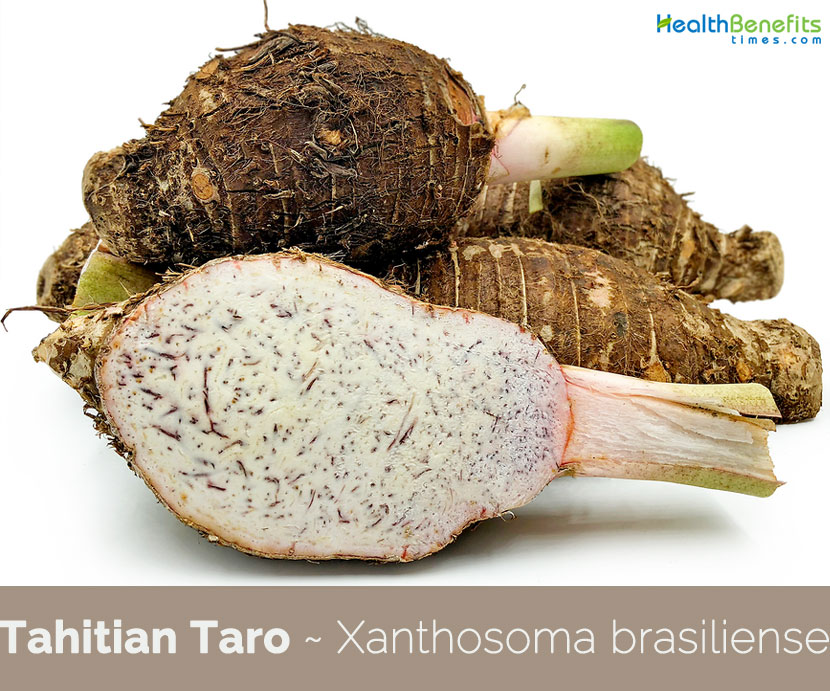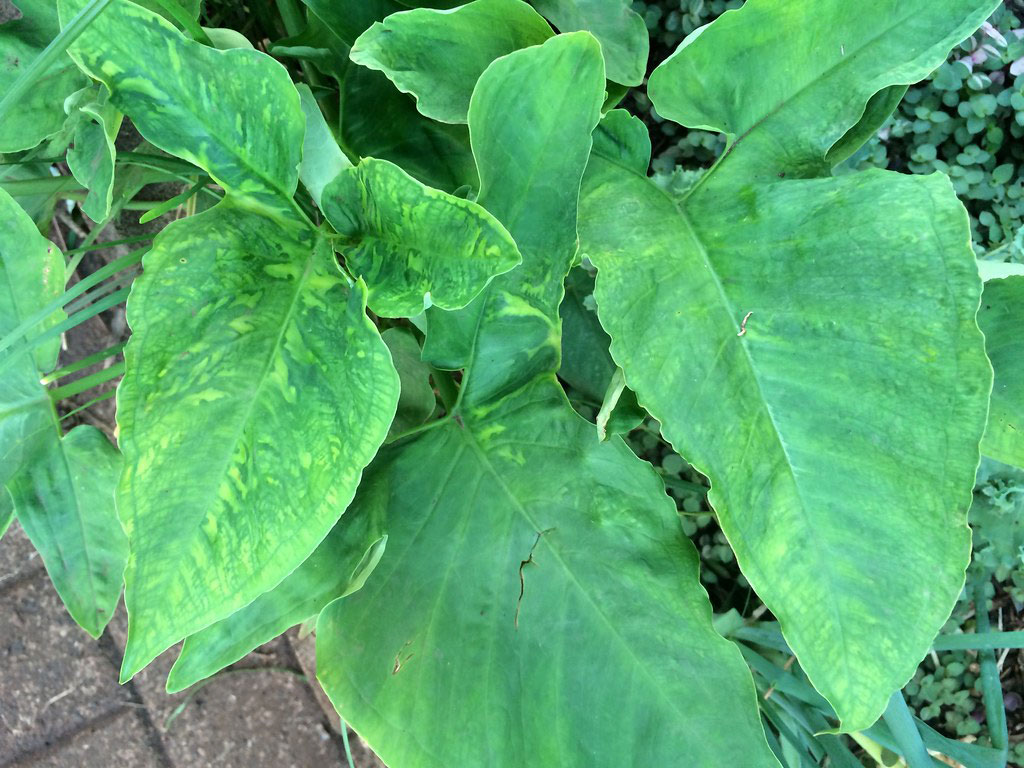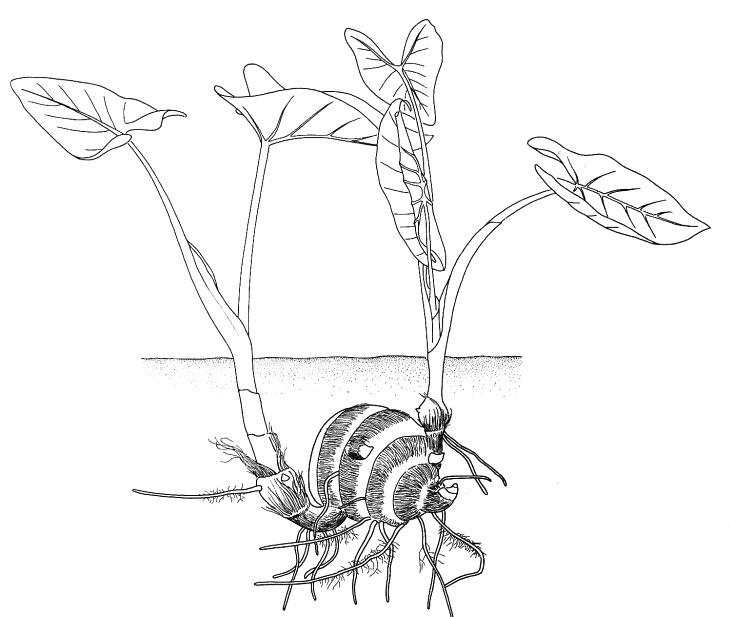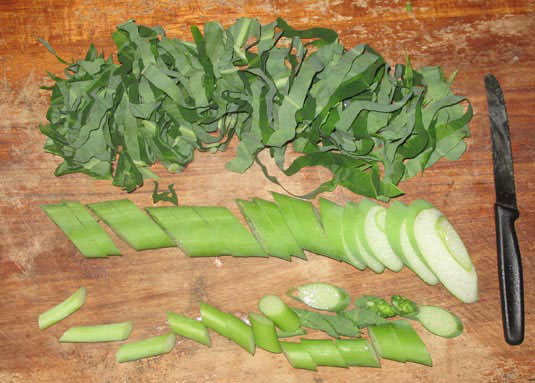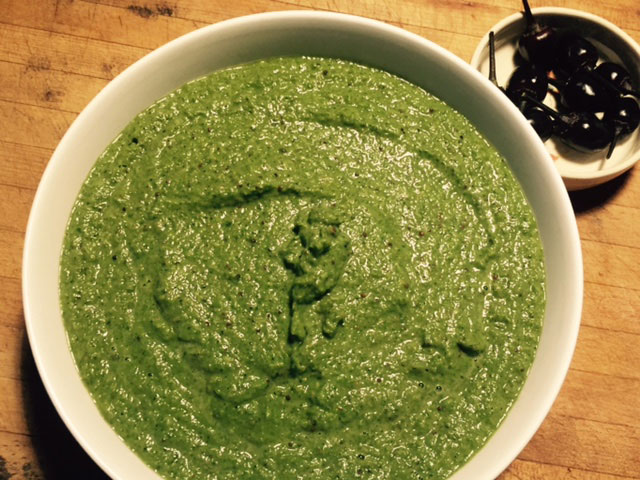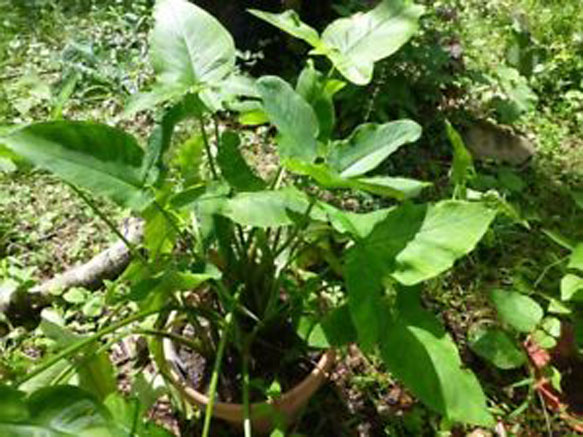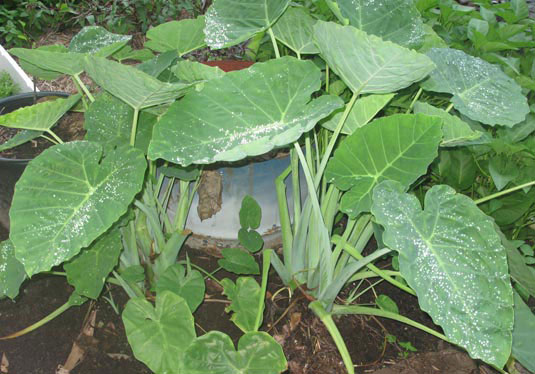| Tahitian Taro Quick Facts |
| Name: |
Tahitian Taro |
| Scientific Name: |
Xanthosoma brasiliense |
| Origin |
Tropical South America and the West Indies |
| Calories |
60 Kcal./cup |
| Major nutrients |
Vitamin C (57.89%)
Iron (26.75%)
Vitamin B2 (20.85%)
Calcium (20.40%)
Potassium (18.17%)
|
Xanthosoma brasiliense commonly known as Tahitian taro, Tahitian spinach is a species of flowering plant in the Araceae (Arum family). The plant is native to tropical South America and the West Indies. Few of the most popular common names of the plant are Tahitian spinach, tannier spinach, belembe, Tahitian taro, calalou, Celery stem Taro, Elephant Ear and Kalalu. It is one of several leaf vegetables used to make callaloo, and it may be called calalu in Puerto Rico. This plant was domesticated in the Amazon and it is now grown throughout tropical regions of the world. The leaves and stems are cooked and eaten as vegetables. It is cooked to remove calcium oxalate crystals, which are present in the leaves of aroids. Unlike some other tannia (Xanthosoma spp.), the corms are not used for food because they are small and underdeveloped.
Plant Description
Tahitian Taro is a non-woody forb that grows about 2 to 6 feet (0.6-2m) tall. The plant is found growing in River valleys and normally succeeds in full sun or light shade in loamy and clay soils, but dislikes sands. It also requires high levels of organic matter in the soil. Stem is always hypogeous, rhizomatous, and cylindrical, up to 6 cm in diameter, moderately covered by brown fibers, producing occasional globose-turbinate cormels.
Leaves
Tahitian Taro plant consists of about 3-4 leaves per plant. Petioles are 45-95 cm long, green, sometimes tinged with purplish at base, never conspicuously waxy, sheathed up to 1/3 of its length, sheath convolute with purplish margins. Leaf blade is 19-33.5 long and 21-39 cm wide, sub-hastate to hastate in young leaves, hastate to sub-pedate in adult plants, glossy green adaxially, clearer and matte abaxially. Primary lateral veins are 4-7 per side, arising at an angle of 40-45°, concolorous with blade at both sides, apex acuminate. Basal ribs denuded for 2.5-6 cm, basal lobes strongly extrorse, obtuse to round at apex.
Inflorescence
Inflorescence is 1-2 per axil. Peduncle is 20-25 cm long and 0.5 cm wide; spathe is 18-19 cm long, tube 5 cm long and 2.5 cm wide, green outside, white inside, lamina 13-14 x 3 cm long, white in both sides. Spadix is 14-16 cm long, fertile male portion white 10 x 1-1.5 cm, acute at apex, sterile male portion 3.5 x 1.1 cm, white, weakly dimorphic, female portion 2-3 cm long and 1 cm wide, pale yellow.
Nutritional values
Apart from their amazing taste Tahitian Taro is a good source of nutrients, vitamins and minerals. Consuming 137 gram of Tahitian Taro offers 52.1 mg of Vitamin c, 2.14 mg of Iron, 0.271 mg of Vitamin B2, 204 mg of Calcium, 854 mg of Potassium, 121 µg of Vitamin A and 70 mg of Magnesium.
Culinary Uses of Tahitian Taro
- Leaves and stems can be consumed after cooking.
- The tender young leaves have a mild flavor and are preferred by some people to the older leaves.
- The leaves make excellent spinach so long as they are not overcooked, and are widely seen as a very superior type of spinach.
- The leaves wilt quite rapidly after harvesting and so should either be consumed immediately or stored in a cool place wrapped in banana leaves or something similar in order to keep them fresh.
- Corms can be consumed after being cooked.
- The corms are quite small and not very starchy, so they are not often used as a food.
- Dice and sauté stems and serve as a side dish or in soups.
- These greens are mild in flavor and are excellent additions to stir-fries, stuffing, soups and stews.
Rodman’s Tahitian Luau Empanadas
Ingredients
- 1 pound Tahitian taro leaves, cleaned, stemmed and chopped
- 1 cup roasted kabocha squash pulp
- 2 cups brown rice, cooked and cooled
- 1 onion, diced
- 2 garlic cloves, minced
- 1 tablespoon organic canola oil
- 2 cups water
- 1 teaspoon salt
- freshly ground pepper, to taste
Directions
- Warm oil in a large pot over medium heat and add onions, garlic and salt.
- Cover, turn heat to medium-low and sweat onions until translucent, about 5 minutes.
- Add Tahitian taro leaves and water and cook until tender, about 10 minutes.
- Cool to room temperature.
- In a bowl, combine pumpkin, brown rice and 1 cup taro leaf mixture.
- Stir to combine and season to taste.
- Place one tablespoon of mixture on a corner of the won ton wrapper, leaving a 1/2-inch border.
- With your finger, wet two sides of the wrapper’s edge with water.
- Fold wrapper over mixture and press edges so they seal.
- Bake or fry until golden brown.
Precautions
- All parts of the plant contain calcium oxalate crystals. This substance is toxic fresh and, if eaten, makes the mouth; tongue and throat feel as if hundreds of small needles are digging in to them.
- People with a tendency to rheumatism, arthritis, gout, kidney stones and hyper-acidity should take especial caution if including this plant in their diet.
References:
https://www.itis.gov/servlet/SingleRpt/SingleRpt?search_topic=TSN&search_value=42583#null
https://davesgarden.com/guides/pf/go/53990/
https://plants.usda.gov/core/profile?symbol=XABR
https://en.wikipedia.org/wiki/Xanthosoma_brasiliense
https://npgsweb.ars-grin.gov/gringlobal/taxonomydetail.aspx?42083
http://www.theplantlist.org/tpl/record/kew-215076
http://www.plantsoftheworldonline.org/taxon/urn:lsid:ipni.org:names:269304-2#distribution-map
https://gd.eppo.int/taxon/XATBR
https://www.ctahr.hawaii.edu/NEW/fjgi/Garden/pop-tahitiantaro.htm
http://en.hortipedia.com/wiki/Xanthosoma_brasiliense#
Comments
comments


